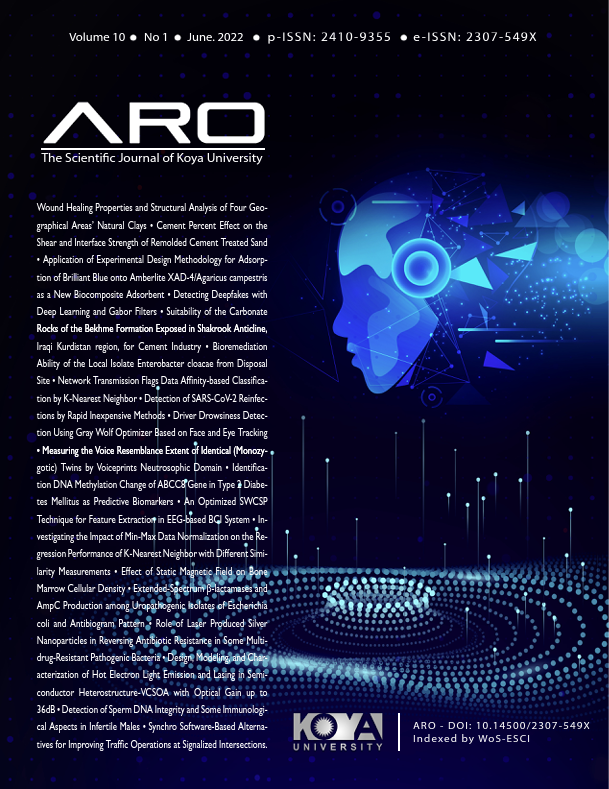Cement Percent Effect on the Shear and Interface Strength of Remolded Cement Treated Sand
DOI:
https://doi.org/10.14500/aro.10805Keywords:
cement treated sand, interface strength, Remolded soil, Shear strengthAbstract
This research aims to simulate the behavior of remolded cement treated poorly graded sand in term of shear and interface strength using the direct shear test. Different percentages of cement up to 15% by weight are added to the soil samples. Compacted cement treated soil samples are prepared at the optimum moisture content and left for 28 days in the humidity room then distributed to use them for the remolding samples preparation. The shear strength parameters for both cases soil to soil interface and concrete to soil interface are predicted, where the results show that the interface strength parameters are higher than the shear strength parameters of the remolded soil samples. The increase in cement percent increases the cohesion (C) of the treated soil, whereas the interface cohesion (Cint.) has a maximum value at 10% of added cement, and the maximum percent between cohesion (Cint.) and soil cohesion (C) is of 76.2% at 0% added cement. Moreover, the results show an increase in the interface angle of friction (δ) and a decrease in the angle of friction (φ) as the percent of cement increases. The maximum percent between interface angle (δ) and angle of friction (φ) is 63.5% at 15% of the added cement. The hardened cement in the remolded case adheres to sand grains and works as soil grains with different sizes that lead to changes in the shear properties of the soil.
Downloads
References
Acar, Y.B., Durgunoglu, H.T. and Tumay, M.T., 1982. Interface properties of sand. Journal of Geotechnics, 108, pp.648-654.
ASTM, 2020. Annual Book of American Standards for Testing and Materials, Part 8. Vol. 4. ASTM, United States.
Braja, M.D. and Sobhan, K., 2014.In: Shortt CM, editor. Principles of Geotechnical Engineering. 8th ed. Christopher M. Shortt.
Broms, B.B., 1963. Discussion on bearing capacity of piles in cohesionless soils. Journal of the Soil Mechanics Division of the ASCE, 89, pp.125-126.
Feng, D.K., 2012. Three-Dimensional Constitutive Laws, Mechanism and Model of Gravel-Structure Interfaces, PhD Thesis, Tsinghua University, Beijing.
Hou, W.J., 2008. Research on monotonic and cyclic behavior and constitutive model of three-dimensional soil–structure interface, PhD thesis, Tsinghua University, Beijing.
Hu, L.M. and Pu, J.L., 2001. Experimental study on mechanical characteristics of soil-structure interface. Chinese Journal of Geotechnical Engineering, 23, pp.431-435.
Hu, L.M. and Pu, J.L., 2003. Application of damage model for soil-structure interface. Computers and Geotechnics, 30, pp.165-183.
Noorany, I., 1985. Side Friction of Piles in Calcareous Sands, Proceedings of the 11th International Conference of Soil Mechanics and Foundation Engineering, Cambridge, USA, pp.12-16.
Potyondy, J.G., 1961. Skin friction between various soils and construction materials. Geotechnique, 11, pp.831-853.
Suganya, K. and Sivapullaiah, P.V., 2020. Compressibility of remolded and cement-treated Kuttanad soil. Soils and Foundations, 60, pp.697-704.
Uesugi, M., Kishida, H. and Uchikawa, Y., 1990. Friction between dry sand and concrete under monotonic and repeated loading. Soils and Founds, 30, pp.115-128.
Watabe, Y., Kaneko, T. and Wantanabe, Y., 2016. Cement mix proportion for treated soils recycled from a cement treated soil. Japanese Geotechnical Society Special Publication, 4, pp.168-172.
Downloads
Published
How to Cite
Issue
Section
License
Authors who choose to publish their work with Aro agree to the following terms:
-
Authors retain the copyright to their work and grant the journal the right of first publication. The work is simultaneously licensed under a Creative Commons Attribution License [CC BY-NC-SA 4.0]. This license allows others to share the work with an acknowledgement of the work's authorship and initial publication in this journal.
-
Authors have the freedom to enter into separate agreements for the non-exclusive distribution of the journal's published version of the work. This includes options such as posting it to an institutional repository or publishing it in a book, as long as proper acknowledgement is given to its initial publication in this journal.
-
Authors are encouraged to share and post their work online, including in institutional repositories or on their personal websites, both prior to and during the submission process. This practice can lead to productive exchanges and increase the visibility and citation of the published work.
By agreeing to these terms, authors acknowledge the importance of open access and the benefits it brings to the scholarly community.
Accepted 2022-01-29
Published 2022-02-19
















 ARO Journal is a scientific, peer-reviewed, periodical, and diamond OAJ that has no APC or ASC.
ARO Journal is a scientific, peer-reviewed, periodical, and diamond OAJ that has no APC or ASC.